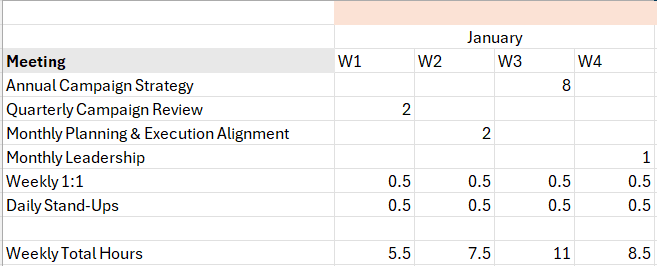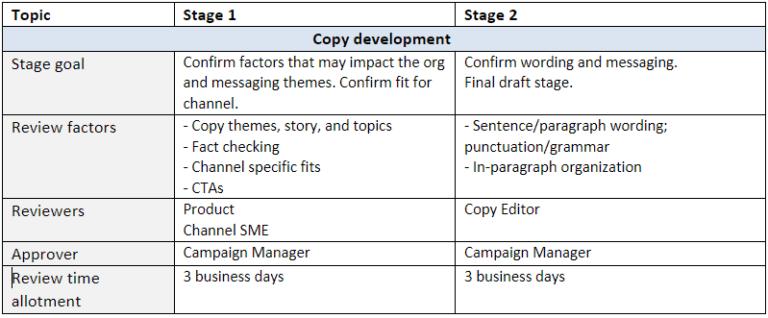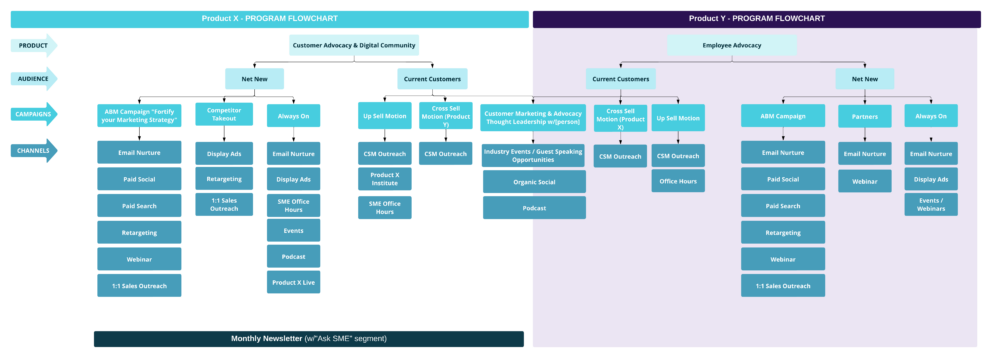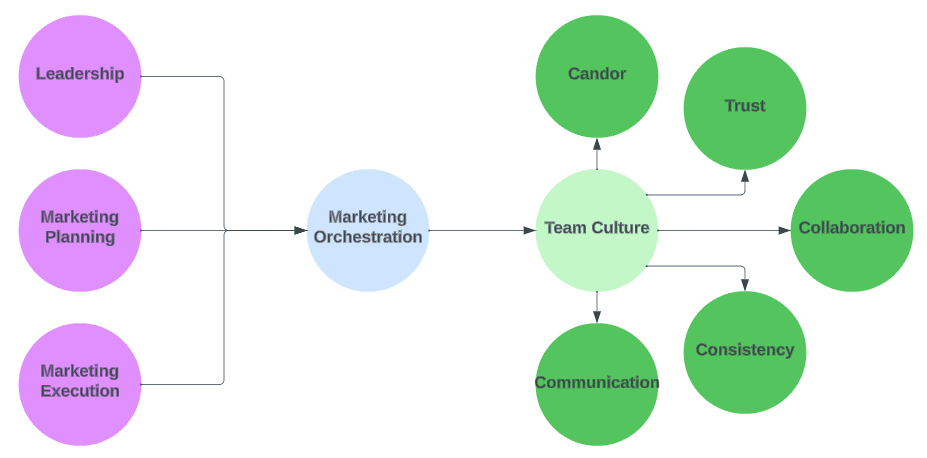Marketing Orchestration Fails Without Communication

Summary
Dive into this post to learn actionable ways to implement communication processes to strengthen your Marketing Orchestration.
By Brenna Lofquist, Client Services Operations Manager at Heinz Marketing
Everyone has heard variations of “communication is key” throughout their lives, but we’re going to talk about it again. Communication is one of, if not the most, important aspect of a successful Marketing Orchestration strategy.
In the dynamic landscape of B2B marketing, where strategies evolve rapidly and buyer’s behaviors shift constantly, effective communication stands as the cornerstone for success. From the initial stages of planning to the execution of campaigns and beyond, seamless communication within teams and across departments is indispensable for achieving your revenue goals.
So let’s delve into the pivotal role of communication throughout the marketing orchestration process, emphasizing its significance during testing, how to implement feedback loops, and how to garner meaningful feedback.
Identifying Key Communication Points
There are many points of communication throughout the Marketing Orchestration process so your first step should be to identify those.
Examples include:
- Annual campaign strategic review
- Bi-annual leadership evaluation meeting
- Monthly leadership meeting
What’s needed for each of these?
- A meeting?
- Review?
Now that you have defined the communication points and what’s needed for each, you’ll need documentation.
Documentation Tools
Determine documentation needed for the different communication points. Two examples are a meeting cadence calendar and a review process. Outlined below are what should be included for each example.
Meeting cadence calendar
Developing a meeting cadence calendar will provide a central resource for teams to easily see which meetings happen how often and who all is included. Each meeting should be defined with:
- Purpose: What do you want to walk away with?
- Owner: The person who owns the meeting invite including creating an agenda and assuring all required attendees are invited and will be present
- Attendees: The people required to attend the meeting
- Meeting Lead(s): The person(s) responsible for creating the presentation or preparing the materials and leading the discussion
- Script: The notetaking including listing next steps/action items and noting follow up questions
- Duration: How long should the meeting last?
- Frequency: How often does the meeting occur?
A calendar can easily be created via Excel, planning tool, or project management platform. To take it one step further, include a table that totals the number of hours for a role or team to understand overall capacity and workload.
Here’s an example:

Review Process
Mainly for execution, different assets or projects require a different number of review stages, involve different roles or teams, and have various review cycles. There are a few rules to abide by when creating and implementing a review process.
- Review process documentation needs to include clear guidelines for what can and cannot be changed at each review stage, as well as who is involved
- Reviewers and approvers should be clearly assigned and agreed upon by all parties involved
- When a review stage is passed all review factors in that stage are no longer up for review in future stages
- If an exception is needed, it will require Approver agreement to revert to the appropriate previous review stage, and will be logged for future process updates
- Reviewers agree to give feedback in a timely manner (SLAs are defined in the project management tool or whatever is used to track projects)
Categorize assets and projects into groups depending on the number of review stages and who’s involved (i.e., creative development and copy development). For each group define the number of review stages. Each stage should including the following:
- Stage goal: The outcome of the review stage
- Review factors: What can be reviewed
- Reviewers: Role(s) responsible for reviewing
- Approver: Role(s) responsible for approving. Try to keep this to one person/role
- Review time allotment: The number of business days to complete the review
Here’s an example:

Garnering Meaningful Feedback
Now that you have identified the key communication points you need to implement a process to gather meaningful feedback and determine a process of reviewing feedback, determining a solution, and communicating out the solution.
Before we dive into that, we need to discuss at which points of the process you need feedback.
New to Marketing Orchestration
If you are just getting started developing a marketing orchestration strategy initial feedback is key. Spend time with all involved to figure out what’s working and what’s not. You don’t want to fix something that isn’t broken and it’s important that those involved know you are taking their thoughts into consideration before developing a new strategy and process.
Here are a few ways to garner meaningful feedback from your teams. This will vary depending on how your teams are structured and the dynamics between people and teams. You will likely need to use a combination.
Interviews
- Start by interviewing a team
- In some cases, it will be necessary to conduct 1:1 interviews to delve deeper into their perspective and insights
- Provide the goals of the interview ahead of time and ask those involved to come prepared
- Come to the interview with probing, open-ended questions
- For team interviews make sure to provide an opportunity for each member to answer
Feedback forms
- Distribute feedback forms or suggestion boxes where employees can submit anonymous feedback and ideas
- Forms should be easily accessible, user-friendly, and encourage constructive criticism
- Provide detail on how the feedback will be used
Workshops
- Helpful to get multiple teams and people in the same room to collectively assess the existing process and pain points
No matter which method(s) you choose make sure you are actively listening to employees’ concerns, validate their experiences, and demonstrate genuine interest in addressing their feedback as you develop the strategy. This is not the time to figure out solutions.
Lastly, another component to garner meaningful feedback is to create a culture of trust with your organization. Employees are likely to provide feedback when they feel more comfortable.
Marketing Orchestration is in full swing
Once your MO process is in place you need to ensure you have ways to continuously collect and handle feedback. Feedback isn’t a one and done type of thing. In addition to the three methods listed above here are a few others.
Feedback sessions
- Dedicated sessions where people and teams can share their experiences, observations, and suggestions regarding the process
- Encourage open dialogue and active participation by creating a supporting environment where individuals feel comfortable expressing their opinions
- Consider facilitating these sessions in smaller groups to foster more intimate discussions and collaboration
Process observation
- Especially important in the testing process, sit in meetings and discussions in real-time to gain firsthand insights into process challenges, pain points, and areas of improvement
- Take note of recurring issues, deviations from standard procedures, or inefficiencies that may impede productivity
- Observational feedback provides valuable context and complements insights gathered through other methods
Exception handling
- Provides an opportunity for those involved to note issues directly in the process
- This can be done manually via Excel or project management tool (preferred)
- To develop an exception handling process you need to define:
- Potential exceptions – can be categorized if multiple fall under one group
- Roles and responsibilities – who is responsible for logging exceptions, developing a solution, providing status updates, etc.
- Define how the information will be used
Post-mortems
- These are especially helpful when testing. Schedule a meeting after the test with all involved to discuss what went well, what didn’t go well, and ask for feedback about the overall process
Communication throughout testing
Many of the methods mentioned above can and should be used throughout testing. You are never going to develop a MO strategy that’s perfect right out of the gate. Testing gives you the opportunity to launch the process and figure out the kinks. The best way to see where things are broken is to try it out.
Testing lays the groundwork for success, and effective communication is key to its execution.
Here are some steps to ensure consistent communication while testing:
- Schedule weekly check-ins with the project manager
- The cadence may vary depending on what part of the process you are testing
- For example, if you are testing the execution part of the process more frequent (weekly) check-ins will work best because things move rapidly
- Ask open-ended questions to probe for potential issues or roadblocks in the process. You can create a standard set of questions that can be used each time.
- Prior to the test launch, conduct a training with all involved
- Include channels they should use to provide feedback
- Make sure they know you’ll be meeting with the project manager weekly, so if they feel comfortable, they can provide feedback to the PM that will be communicated during the check-in
- Log feedback and determine what can be adjusted or resolved on the fly and what needs discussion
- Communicate the process in reviewing feedback, how it will be used, and how changes will be communicated.
- Schedule a post-mortem (as mentioned above) to identify roadblocks and improvements
- Implement changes to the process and communicate out to the broader team
In summary
Effective communication is not only a nicety but a strategic imperative. From testing and feedback loops to optimizing strategies based on performance insights, communication permeates every facet of the marketing orchestration process. By fostering a culture of collaboration, transparency, and continuous improvement, organizations can harness the power of communication to drive meaningful results and achieve revenue goals in an ever-evolving market.
It’s time to act! Go through the process outlined in this post to develop and implement processes for clear and consistent feedback with your teams.
Have questions or want to chat communication or Marketing Orchestration? Reach out any time brenna@heinzmarketing.com.







